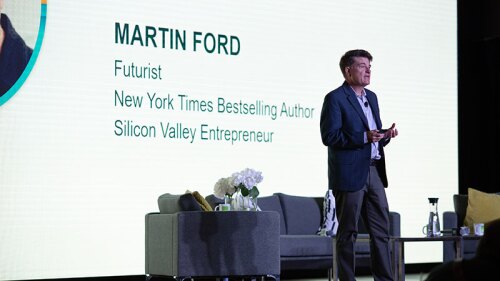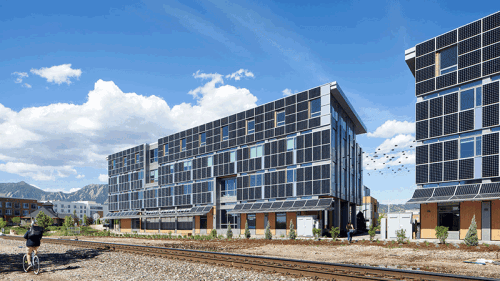Resiliency teams from leading real estate firms discuss challenges and models at ULI Fall Meeting.
It’s been 10 years since the eastern United States experienced Superstorm Sandy, which many in the commercial real estate industry consider a watershed moment in understanding and accepting what climate change and natural disasters can do to society and the real estate where people live and work.
The strategy to address climate change’s impact on real estate development and deals went from being a “nice to have” to a “must have,” said Brian Swett, Americas East leader at Arup, as he led sustainability leaders through a discussion on resiliency during ULI’s Fall Meeting in Dallas.
Panelists included Holley Chant, director of sustainability, Lendlease; Rebecca Becker, assistant vice president, environmental and climate adaptation, Equity Residential; and Eric Duchon, managing director and the global head of Real Estate ESG, Blackstone.
“We have so much more data now to help us understand and make decisions now,” said Swett.
He pointed to the 100 Resilient Cities program, launched in 2013 by the Rockefeller Foundation, which has invested $100 million in the pursuit of urban resilience worldwide.
The program brought together cities, experts, and public and private organizations through its platform partners, sponsors a Chief Resilience Officer and offers innovative financing and technology for members. Swett was one of the chief resilience officers hired as part of the program.
“Previously, policy changes were always focused on the worst-case situations that had happened in that area, now they are forward looking,” Swett said. “They are creating building codes that make sense for what weather events are potentially forecast to happen. Boston has created future flood mapping and New York has [its eye on the future].
“Climate change mitigation is now mainstream,” Swett said.
“We know we must provide robust answers to investors’ questions today,” Chant said. “Just having insurance is not enough anymore if we want to be able to raise capital to deploy and keep the wheels turning.”
She said it’s crucial to present the executive suite to resiliency data.
By doing that, “they will quickly understand why it’s so important to invest in resiliency efforts, and it shows them the opportunities that can come from it. Don’t silo your department and your information.”
ULI is helping to lead the way with achieving net zero program goals through Greenprint guidance.
Lendlease Consults Third-Party Engineering Firms
Becker said Equity Residential’s (EQR) sustainability and resiliency program involves analyzing its assets and forecasting to 2030, 2050, and 2070, based on what hazards it anticipates could occur throughout its portfolio.
Swett said that heat is potentially the most harmful climate change condition today. In turn, EQR created a heat stress index that helps it analyze best use for its capital.
Becker said EQR’s evaluations measure risks for drought, flood, hot and cold temperatures, wildfire, and earthquakes and can be done “by market” or “by asset” basis.
In one example, Lendlease discovered it had a property in Jersey City, N.J., that was susceptible to flooding so it hired a third-party engineering firm to examine its elevations and make recommendations. It ended up installing flood gates near vulnerable equipment at the location as a precaution.
In another, a southern California asset was in line for potential wildfires, so Lendlease scheduled more frequent gutter cleanings to reduce dangerous, accumulating pine needles, replaced mulch, and created better defensible spaces around the property’s perimeter.
LendLease Applies TCFD Guidelines
Lendlease, which has earned a prestigious 5-star ranking from GRESB for its residential portfolio, located mostly gateway cities near water.
It has 12 employees on its US sustainability team. Sustainability lies firmly in the company’s core values, and Lendlease has a goal to get to net zero by 2025 and become absolute zero by 2040.
It uses the Task Force on Climate-Related Financial Disclosures (TCFD) regulations and reporting. Created in 2015 by the Financial Stability Board (FSB), TCFD has developed consistent climate-related financial risk disclosures for use by companies, banks, and investors in providing information to stakeholders.
“This reporting helps us to articulate our strengths,” said Chant, adding that Lendlease’s goals align with the 1.5-degree threshold.
Lendlease also uses a proprietary dashboard to assess any asset that it bids on, measuring risks related to it out to 2100.
Blackstone Relies on XDI Forecast Models
Duchon said that from an investor perspective, “many of our assets are ones that we control, which means we can influence their performance.
“On the debt side, we don’t control them, so we do a higher degree of due diligence before making the loan. We engage with the borrowers to make sure they have the right amount of risk coverage in place and ask them, ‘What are you going to do about mitigating that risk?’ ”
Blackstone also evaluates assets for short-term and long-term holds so it can determine when the property could be at risk. For example, if a property is not forecast to be sold until 2040, the owners will consider the risk accordingly.
When considering an asset’s exposure to climate risks, Blackstone conducts a portfolio screening, a detailed analysis, and uses the cross-dependency initiative (XDI) forecasting model.
XDI can identify properties structurally unable to withstand hurricanes and cyclones, and whose location—because of climate change—puts them increasingly at risk.
Duchon said one key component of its asset analysis is to determine if the asset is operable given what is around it and if that area is also resilient.
“Will others be able to reach the asset after a catastrophic event concerns us,” Duchon said.
Blackstone also relies on what it hears from its staff on the ground about what they are doing and seeing and is developing a climate playbook that will be provided to all its deal teams who will also undergo training on the book’s applications.


